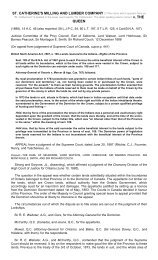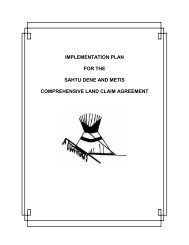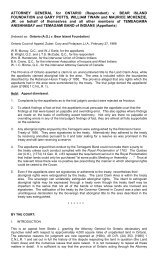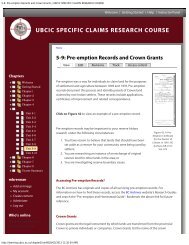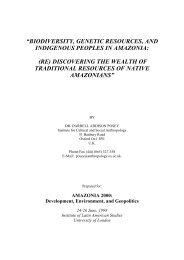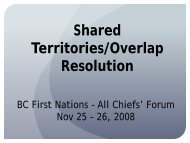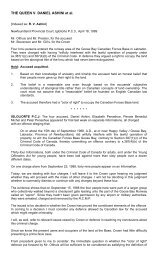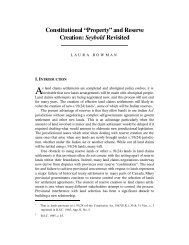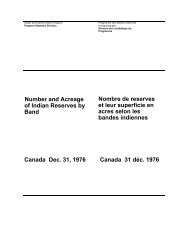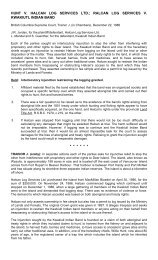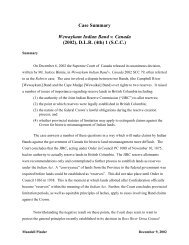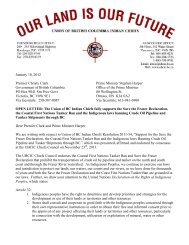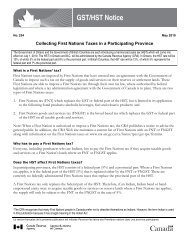ATTORNEY-GENERAL OF ONTARIO v. FRANCIS ET AL.
ATTORNEY-GENERAL OF ONTARIO v. FRANCIS ET AL.
ATTORNEY-GENERAL OF ONTARIO v. FRANCIS ET AL.
- No tags were found...
You also want an ePaper? Increase the reach of your titles
YUMPU automatically turns print PDFs into web optimized ePapers that Google loves.
eing, as I thought, conceded that if it had been cut upon the reserve the cutting was done underproper authority so to do, but if done upon land not part of the reserve, it was wrongly done withoutany authority. These statements were certainly more than once made by counsel. Upon the finalargument, however, counsel dissented from this as being the sole matter and contended thatwhether the cutting was done upon the reserve or not the property in the land and timber being (aswas contended) vested in the Ontario Government, the cutting complained of was wrongful andcould not be justified under any licenses issued under the authority of the Dominion Government.The plaintiff asks, as I have said, that the true locality of this reserve should be declared. This is oris similar to asking for a declaration of right, and my duty in this respect is to fix the boundaries ofthe reserve as well as I can upon the evidence.The words in the schedule of the treaty are certainly very meagre for this purpose. I may firstdispose of the concluding words "seven miles inland" by saying that after hearing the evidencethat was given in regard to the Indians' understanding, or rather want of understanding, of themeaning of the word "mile"; and general evidence as to the locality that was occupied by this bandof Indians at the date of the treaty; and as to the distance of any part of the locality so occupiedfrom the main waters; and the evidence as to the word in their language used by themindiscriminately to signify the measure of distance or any other measure such, for instance, as abushel; counsel very properly, I think, abandoned any contention resting upon the use of thesewords. The distance from the main waters to the nearest part of the lands at the time of the treatyoccupied by this band of Indians seems to have been more than twice seven miles, but this is notto make any difference.In taking the evidence for the purpose of ascertaining the meaning of the Treaty so far as itrelated to the rights and interests of this band of Indians, evidence was given and receivedrespecting the preliminary facts and instructions to the agent or plenipotentiary of and on behalf ofthe Government (the Crown). Evidence was offered respecting the preliminary facts on the otherside: that is to say, the instructions that were given to the chief of the band, Shewanakishick, bythe Council of his band convened for the special purpose of such instructions; that is, instructionsas to what territory he was to claim as being in the occupation of the band and to which theyshould be entitled as a reserve. Such evidence was objected to, but was received subject to theobjection. I am of the opinion this evidence was properly received, and that the objection to it couldnot be sustained. I think that for this or a like purpose this band of Indians should be consideredas standing in the same position as any other high contracting power or government, and it is aproposition of law that if an agent of a government exceed his authority, the principal is not bound.For this reason I think both the instructions and the contract must be seen in such a case. (1) Storyon Agency, sec. 307a, 8th. Ed., and notes and cases there referred to. By the law of agency at common law there isthis difference between individuals and the government: the former are liable to the extent of the power they haveapparently given their agents while the government is liable only to the extent of the power it has actually given to itsofficers. etc. Besides, it would seem to be improper to receive such evidence on the part of one partyto the contract and not on behalf of the other party. I may here remark that the Indian witnessesappeared to me to give their evidence with a high degree of candour and much intelligence. Theinterpreter was, I think, an excellent one. I did not, with, I think, very careful observation, notice asingle instance in which I was disposed to doubt the veracity of the witness.On the subject to which I have last referred, Mongowin, the chief of the Band, was called and hesaid, "Shewanakishick was my father and the chief before me. I remember my father getting amessage to go to the Sault to see about a reserve for the band. I do not know my own age. I wasgrown up at the time of the message. I remember my father calling a council in consequence ofgetting the message. The meeting was held where I now live at the Whitefish Lake. I was presentat the meeting. My father told the people or asked the people: 'shall I reserve so much', and theyanswered, 'Yes'." Here the objection was interposed, and after it was disposed of the witness said:"I will endeavor to follow the road around the proposed Reserve that was then mentioned". This hedid by mentioning objects and places in the Indian tongue, nine in number. He commenced with:1. Nebenenekahming--which was translated to mean "the place of the high cranberries", aplace known as Cranberry Lake. He says this was mentioned at the council.2. [Anhasahquah(?)]. This is the name of a lake near the house of the Hudson Bay agentimmediately north of Whitefish Lake.3. Mahdahgohming. This is the name of the next lake to the west of the last mentioned one [.]The name means "where the waters stir".4. Koshgo[wee wee]shing. The witness said this was the name of a lake [nam]ed by f[our?]people, and that the waters he had before mentioned run into it.5. Keecheemenessing. This means "great island". The witness says it is in Washkahgahminglake, and that the waters of this Lake flow down to the waters of the Great Lake (Huron).



